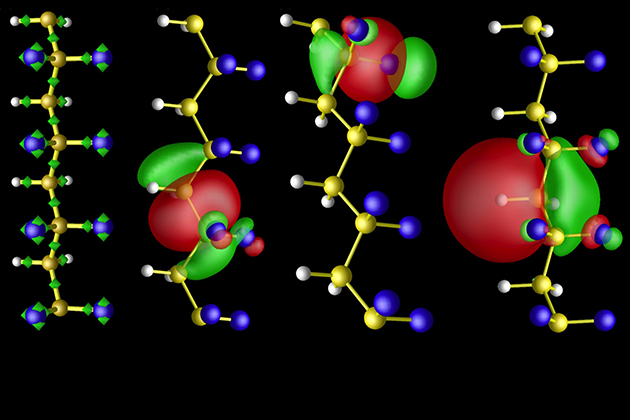
Serge Nakhmanson describes himself as a ‘digital alchemist.’ A former scientist with the Argonne National Laboratory, he specializes in the computer-based design and discovery of advanced multifunctional materials.
Nakhmanson spends countless hours in his research lab painstakingly tweaking the identities of individual atoms and altering their chemical bindings in an attempt to assemble new material templates that have superior physical or chemical behaviors. Those virtual materials may exhibit enhanced electrical conductivity or mechanical toughness. Or, in some cases, an entirely new material may be created that performs differently from anything else known to exist.
Rational design

“I consider myself a digital alchemist,” says Nakhmanson, who joined UConn’s School of Engineering as a full-time associate professor last August. “We are trying to design new materials on the computer and we want to do this in some rational fashion. That is, as opposed to an Edisonian approach, where you’re baking random compounds in 100 different ovens in the hope that something interesting serendipitously comes out of one of them.”
Nakhmanson is one of three new faculty members specializing in computational materials theory who have been added to UConn’s Institute of Materials Science (IMS) over the past two years as part of a targeted expansion of the University’s materials genomics and informatics research cluster. Those new faculty are in addition to 10 computational modeling specialists already on staff.
Materials genomics is critically important. Two years ago, President Barack Obama launched the Materials Genome Initiative, encouraging private industry and academic institutions like UConn to accelerate and share their research and development of basic materials science in order to spur innovation – much like geneticists shared DNA data through the Human Genome Project.
S. Pamir Alpay, professor and head of Materials Science and Engineering department, says Nakhmanson is a welcome addition to the materials science community at UConn.
“The Materials Science & Engineering department is pleased to be able to hire Serge Nakhmanson as a part of the ongoing materials genomics and informatics efforts at UConn,” Alpay says. “Serge’s expertise in modeling of multifunctional ferroic materials at multiple length scales will significantly strengthen our materials theory core.”
The importance of intuition
Nakhmanson’s research strongly depends on collaborations with experimentalists, who grow and characterize the functional materials and nanostructures he creates.
“The idea is to find something that already exists in nature and may even be well known, and then study it in minute detail to learn more about what makes this material behave the way it does,” Nakhmanson says. “It is like trying to solve a brain teaser. Eventually, you may learn enough to understand how to alter the compound you have in order to create a better version of it. Or you may occasionally get surprised when the changes you make produce something completely unexpected.”
Nakhmanson views his work as the pursuit of satori, the Japanese Buddhist term for “sudden enlightenment.”
“Although a number of new computational strategies exist to help us do what is called ‘rational materials design,’ the best tool at our disposal is our intuition regarding a material’s chemical and physical properties,” Nakhmanson says. “We have to keep improving our intuition until the process of materials discovery becomes effortless instead of painstaking. Only then will we be able to claim that our satori state, our enlightenment, has been reached.”

Nakhmanson, working with collaborators at Argonne and the University of Illinois at Chicago, recently received a $250,000 National Science Foundation grant to explore ways of incorporating tin, rather than lead, into piezoelectric and ferroelectric materials that are commonly used in sonar devices, sensors, and microelectronics. The idea is to avoid using lead because of its toxicity. But lead has certain unique electrochemical properties that make it hard to replace. Tin on the other hand, is environmentally benign, but requires some digital alchemy (in the form of new custom-tailored compounds) to be persuaded to behave like lead in various applications.
“We’re trying to do something quite difficult here,” Nakhmanson says. “We want to design a set of chemical reactions that will assemble these novel tin-based materials and infuse them with very specific properties that we have envisioned. That is not unlike growing a flower out of a bud by giving it the right amount of sunlight, water, and feed. Our success is not guaranteed, though, as sometimes, despite all your efforts, you realize that the flowers you want will never grow from the buds you have under the conditions you can provide. But even that experience is valuable, because it helps us learn what really works and what does not, and why. The best sort of a research project is one that remains interesting no matter what twists and turns it takes.”
More information about Nakhmanson’s research can be found on his research group’s website: www.satori.ims.uconn.edu/.



